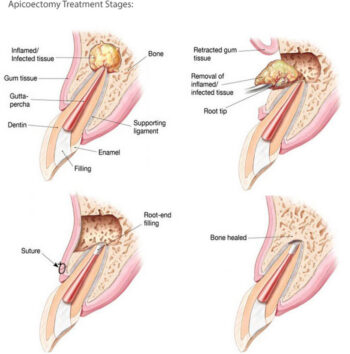Dental Extraction
Tooth extraction refers to tooth removal from the mouth. This could be done if the tooth is severely decayed beyond repair or from gum disease. Other possible relations could be for
- Orthodontic Treatment
- Dental Bridges
- Dentures
- Or Other Restorative Procedures

Impacted Wisdom Teeth

Wisdom teeth are the last four teeth to erupt, generally between the ages of 17 to 25. A fully erupted wisdom tooth can be removed by normal extraction, impacted wisdom tooth on the other hand will require surgery.
Impacted Wisdom Teeth can cause problems such as:
- Repeated infection of soft tissue which leads to Swelling and Pain
- Headache and Stress
- Make your Teeth Crowding
- Extensive Tooth Decay
- Damage to nearby teeth
- Fluid-filled sacs (Cysts)
- Tumors
- Gum disease
- TMJ problem

It is important to have your teeth regularly checked, especially during your late teens and early twenties for early signs of wisdom teeth symptoms to avoid future burdens and financial strains.
Sinus Lift
A Sinus Lift is a minor surgical procedure that adds bone to your sinus cavity to elevate the sinus floor, increasing the volume of bone in the jawbone in preparation for dental implants.
This procedure is usually done simultaneously with a bone graft procedure.

Bone Grafting
Bone Grafting is a procedure that restores bone loss to secure your jaw bone, recreating its height and thickness in preparation for Dental Implants or strengthening the support around a failing tooth.
The bone loss could be from multiple reasons such as:
- Previous Tooth Extraction
- Severe Gum Disease
- Cysts or Tumors in your jaw
- In Response to Face Trauma or Injury

Root End Surgery

Root End Surgery or Apicoectomy is an Endodontic surgical procedure performed on a tooth that had already undergone Root Canal Treatment but isn’t sufficient to save the tooth and prevent further complications. This will be recommended when there is no other option than extracting the tooth, which will then require other restorative procedures to replace the missing tooth.
Gum Surgery (Gingivectomy or Crown Lengthening)
Gingivectomy or Crown Lengthening is the surgical removal of your gum tissues. This treatment is required to treat conditions like gingivitis, which is the early stage of periodontal disease, or for cosmetic purposes such as modifying a smile by removing excess gum. With the advancement of technology, this procedure will be done with laser technology, allowing for a more precise procedure and faster healing time.

Gum Graft (Gingival Graft)

Gum Grafting is a type of Periodontics Surgery used to repair gum recession. If the gum is receding, it can expose the roots of your teeth, making the surface more likely to decay and prone to abrasion.
During the procedure, your dentist will first remove a piece of tissue from the roof of your mouth or nearby healthy gum tissue, which will then be attached to the area where your gums have receded.
Dental Implant
Whether you have lost one tooth or multiple teeth, Dental Implants will always be the best permanent solution you are looking for in terms of natural-looking esthetic and long-term durability.

Dental Implants are a type of anchor surgically placed into the jawbone to act as a support for any type of tooth replacement such as: Crowns, Bridges, Overdentures, and Fixed Dentures.
It helps to:
- Offer the best chewing function with single tooth replacement or full mouth rehabilitation
- Prevent bone loss or bone resorption
- Offer the highest long-term success rate of 95% at ten years compared to other restorative methods.